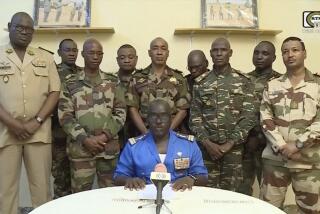Somalia on Its Own as U.N. Leaves
- Share via
MOGADISHU, Somalia — With U.S. Marines pouring out gunfire to safeguard a U.N. retreat, the world gave up on woebegone Somalia today.
The goodby was purely military: 73 hours after landing, the last of the Marines, their machine-gun barrels still hot, rumbled across the beach and splashed their amphibious assault vehicles into the Indian Ocean, bound for home or duty stations elsewhere.
Fading into the distance was the sorrowful pop of Somali gunfire, the national anthem for this disintegrated nation.
For the first time since the United Nations reached out a helping hand, Somalis were left entirely on their own.
Marines thus completed their mission of extracting the United Nations from what had become a deadly, costly, muddled and probably counterproductive campaign.
No American battle casualties were reported from the three-day withdrawal. But by the time the last wave of 15 armored assault troop carriers slipped into the water at 1 a.m. today on a moonless Mogadishu night, the sky had been set ablaze repeatedly by gunfights as Somalis tested the American lines.
Earlier in the operation, five Somalis were confirmed killed by Marines, the U.S. military command said, but the figure may be preliminary. Other Somalis almost certainly died in gunfights among themselves during the rush to reoccupy Mogadishu’s seaport and military encampments as they were vacated.
The Marines, many from Camp Pendleton, and a contingent of Italian marines landed here Feb. 28 to protect the evacuation of 2,400 U.N. peacekeepers, troops from Bangladesh and Pakistan.
The Marines’ stay had been so brief that nobody had bothered to raise the U.S. flag over the military command post. Neither did Americans find need to test their experimental “non-lethal” riot weapons, such as “sticky foam” guns.
Somalia, along with the de-evolution of Yugoslavia, taught the world a sobering lesson. Even powerful coalitions of nations with billions of dollars in resources are arrogant to believe they can impose order or democracy on others.
“The world may have bitten off more than it could chew in terms of trying to bring the Somalis to form a government,” said U.S. envoy to Somalia George Bennett, who sailed away with the naval task force.
Ironically, the U.N. deployment--which included many thousands of U.S. troops from December, 1992, to March, 1994--may have left Somalis united behind one idea: a common disregard for outside meddlers.
Said Bennett: “The people who look at Somalia now with even a small amount of optimism operate from the premise that as foreigners leave, Somalis themselves may be able to get together, close the door and, inside the family, say, ‘OK, now it’s time to wrap this up and make a government.’ ”
The alternative vision for Somalia is harsh--continued warfare between armed clans, sub-clans and bandit militias; an impoverished landscape torn into ever shifting enclaves and absorbed in bloody rivalries; a life of brutal squalor for most of the 9 million Somalis.
*
U.S. armed forces gave up 42 lives here. During its years on the ground, the United Nations lost more than 100. Somali casualties no doubt ran into the thousands. The price tag exceeded $2 billion. But only last week as he prepared to flee the country, U.N. special representative to Somalia James Victor Gvebo said he sensed an end to the country’s fighting.
“The warlords are broke and running out of supplies,” Gvebo said. “Now they will have to think twice before firing once.”
Seventeen hours after his statement, downtown Mogadishu erupted in heavy gun battles that have continued on and off since.
At the start, the U.S.-led, U.N.-sponsored mission was simple enough: To provide protection and logistics support to feed Somalis, the victims of famine aggravated by a civil war. Perhaps 300,000 had died here by the autumn of 1992. That December, Marines landed for “Operation Restore Hope.”
Trouble followed. The relief effort faced a dilemma. Was it enough to feed people and pull out? Or should the world go the next step and help Somalis bring order to their society, which had shattered into clan factions after the overthrow of dictator Mohamed Siad Barre in 1991?
Instead of confronting the question publicly, Americans found themselves incrementally dragged into Somalia’s violent politics.
On Oct. 3, 1993, Army commandos were engaged in an all-night pitched battle with Somali militia. Eighteen Americans and one Malaysian peacekeeper perished. At home, Americans watched television pictures of a naked corpse dragged through the streets of Mogadishu. More than 300 Somalis were believed killed in the fight.
After that turning point, Americans ended their direct engagement as of March, 1994, although they continued to finance 30% of the remaining U.N. peacekeeping effort.
Finally even the United Nations could no longer justify its presence here. The Security Council voted to retreat, and the Marines were once again summoned to Mogadishu.
But there was no fussiness to the mission this time. “Operation United Shield” proved one thing: Somalia was easier to abandon than it was to help or befriend.
More to Read
Sign up for Essential California
The most important California stories and recommendations in your inbox every morning.
You may occasionally receive promotional content from the Los Angeles Times.













